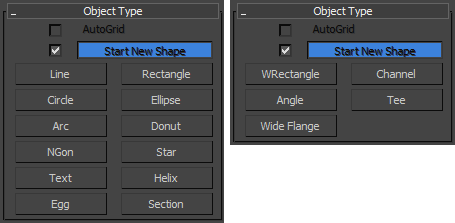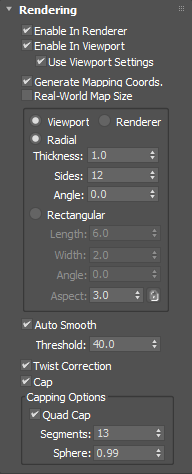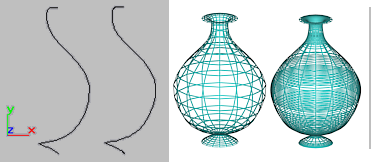
This topic covers general aspects of spline and extended spline creation, including the parameters available on rollouts common to all spline objects. For parameters unique to a particular spline or extended spline type, see the section for that type.
Procedures
To combine shapes while creating them:
- On the
 Create panel, turn off the checkbox next to the Start New Shape button.
Create panel, turn off the checkbox next to the Start New Shape button.
- Click the Start New Shape button.
- Begin creating splines.
Each spline is added to the compound shape. You can tell you are creating a compound shape because all the splines remain selected.
- Click Start New Shape to complete the current shape and prepare to start another.
Issues to remember about creating shapes:
- You can go back and change the parameters of a shape containing a single spline after the shape is created.
- You can create a compound shape by adding splines to a shape: Select the shape, turn off Start New Shape, and then create more splines.
- You cannot change the parameters of a compound shape. For example, create a compound shape by creating a circle and then adding an arc. Once you create the arc, you cannot change the circle parameters.
To create a spline using keyboard entry:
- Click a spline creation button.
- Expand the Keyboard Entry rollout.
- Enter X, Y, and Z values for the first point.
- Enter values in any remaining parameter fields.
- Click Create.
Interface
Object Type rollout (Splines and Extended Splines)

- AutoGrid
-
Lets you automatically create objects on the surface of other objects by generating and activating a temporary construction plane based on normals of the face that you click.
For more information, see AutoGrid.
- Start New Shape
-
A shape can contain a single spline or it can be a compound shape containing multiple splines. You control how many splines are in a shape using the Start New Shape button and checkbox on the Object Type rollout.
The checkbox next to the Start New Shape button determines when new shapes are created. When the option is on, 3ds Max creates a new shape object for every spline you create. When off, splines are added to the current shape until you click the Start New Shape button.
- Shape Selection buttons
-
Lets you specify the type of shape to create.
Name and Color rollout
Lets you name an object and assign it a viewport color. For details, see Object Name and Wireframe Color.
Rendering rollout

Lets you toggle shape renderability in the viewports and rendered output, specify cross-section settings, and apply mapping coordinates.
You can animate render parameters, such as the number of sides, but you cannot animate the Viewport settings.
You can convert the displayed mesh into a mesh object by applying an Edit Mesh or Edit Poly modifier or converting to an editable mesh or editable poly object. If Enable In Viewport is off when converting, closed shapes will be “filled in” and open shapes will contain only vertices; no edges or faces. If Enable In Viewport is on when converting, the system will use the Viewport settings for this mesh conversion. This gives maximum flexibility, and will always give the conversion of the mesh displayed in the viewports.
- Enable In Renderer
-
When on, the shape is rendered as a 3D mesh using the Radial or Rectangular parameters set for Renderer.
- Enable In Viewport
-
When on, the shape is displayed in the viewport as a 3D mesh using the Radial or Rectangular parameters set for Renderer.
- Use Viewport settings
-
Lets you set different rendering parameters, and displays the mesh generated by the Viewport settings. Available only when Enable in Viewport is turned on.
- Generate Mapping Coords
-
Turn this on to apply mapping coordinates. Default=off.
3ds Max generates the mapping coordinates in the U and V dimensions. The U coordinate wraps once around the spline; the V coordinate is mapped once along its length. Tiling is achieved using the Tiling parameters in the applied material. For more information, see Mapping Coordinates.
- Real-World Map Size
-
Controls the scaling method used for texture mapped materials that are applied to the object. The scaling values are controlled by the Use Real-World Scale settings found in the applied material's Coordinates rollout. Default=off.
- Viewport
-
Choose this to specify Radial or Rectangular parameters for the shape as it will display in the viewports when Enable In Viewport and Use Viewport Settings are on.
Available only when both Enable In Viewport and Use Viewport Settings are on.
- Renderer
-
Choose this to specify Radial or Rectangular parameters for the shape as it will display when rendered. These settings are also used for viewport rendering when Enable In Viewport is on but Use Viewport Settings is off.
- Radial
-
Renders the shape with a circular cross section.
- Thickness
-
The diameter of the rendered spline mesh. Default=1.0. Range=0.0 to 100,000,000.0.

Splines rendered at thickness of 1.0 and 5.0, respectively
- Sides
-
The number of sides (or facets) for the rendered spline mesh. For example, a value of 4 results in a square cross section.
- Angle
-
The rotational position of the rendered cross section. For example, if the spline mesh has a square cross section you can use Angle to position a flat side down.
- Rectangular
-
Displays the spline's mesh shape as a rectangle.
- Length
-
The size of the cross section along the local Y axis.
- Width
-
The size of the cross section along the local X axis.
- Angle
-
The rotational position of the rendered cross section. For example, if the spline mesh has a square cross section you can use Angle to position a flat side down.
- Aspect
-
The ratio of width to length. Adjusting Aspect automatically changes the Length setting to establish the indicated aspect ratio with respect to the Width value.
When Lock is on, the Aspect setting is unavailable and adjusting Width or Length automatically changes the other to maintain the aspect ratio.
- Auto Smooth
-
When on, the rendered spline is automatically smoothed using the Threshold setting (see following).
Note: Turning Auto Smooth on does not always yield optimal smoothing quality. For best results, it might be necessary to change the Threshold value or to turn off Auto Smooth, depending on your requirements and the other settings. - Threshold
-
The angle, in degrees, used to determine whether smoothing occurs. Any two adjacent spline segments are put in the same smoothing group if the angle between them is less than the threshold angle.
- Twist Correction
- When enabled, corrects any twists created between the first and last vertices after adjusting bezier handles on closed splines.
- Cap
- Enables capping on renderable splines. When this option is disabled, the ends of splines will not have caps.
Note:
 The end caps of renderable splines now use the same Material ID as the rest of the spline.
The end caps of renderable splines now use the same Material ID as the rest of the spline.
If a renderable spline is assigned a multi/sub-object material, changing the Material ID of a segment also changes the ID of its attached cap. To take advantage of this behavior, edit the UseFixedRenderableEndCapMaterialID parameter in the Shapes section of the 3dsMax.ini file (C:\Users\<username>\AppData\Local\Autodesk\3dsMax\<year> - 64bit\<language>) to UseFixedRenderableEndCapMaterialID=0 and restart 3ds Max.
Capping Options group
- Quad Cap
- Enables quad capping to create cleaner results for such operations as OpenSubdiv, TurboSmooth, and MeshSmooth.
- Segments
- Sets the number of segments in each cap.
- Sphere
- Progressively rounds the caps. More segments create smoother results. A setting of 1 is a perfect hemisphere while a setting of 0 creates a flat cap.
Interpolation rollout

These settings control how a spline is generated. All spline curves are divided into small straight lines that approximate the true curve. The number of divisions between each vertex on the spline are called steps. The higher the number of steps, the smoother the curve.
- Steps
-
Spline steps can be either adaptive (that is, set automatically by turning on Adaptive) or specified manually.
When Adaptive is off, use the Steps setting to specify the number of divisions between each vertex. Splines with tight curves require many steps to look smooth while gentle curves require fewer steps. Range=0 to 100.
- Optimize
-
When on, removes unneeded steps from straight segments in the spline. Default=on.
- Adaptive
-
When off, enables manual interpolation control using Optimize and Steps. Default=off.
When on, Adaptive sets the number of steps for each spline to produce a smooth curve. Straight segments always receive 0 steps.

Optimized spline left and adaptive spline right. Resulting wireframe view of each, respectively, on the right.
The main use for manual interpolation of splines is in morphing or other operations where you must have exact control over the number of vertices created.
Creation Method rollout
Many spline tools use the Creation Method setting where you can choose to define splines by either their center point or their diagonal.
Text, Star, and Freehand splines do not have Creation Method rollouts. Line and Arc splines have unique Creation Methods rollouts that are discussed in their respective topics.
- Edge
-
Your first click defines a point on the side or at a corner of the shape and you drag a diameter or the diagonal corner.
- Center
-
Your first click defines the center of the shape and you drag a radius or corner point.
Keyboard Entry rollout

You can create most splines using keyboard entry. The process is generally the same for all splines and the parameters are found on the Keyboard Entry rollout. Keyboard entry varies primarily in the number of optional parameters. The image above shows a sample Keyboard Entry rollout for the Circle shape.
The Keyboard Entry rollout contains three fields for the X, Y, and Z coordinates of the initial creation point, plus a variable number of parameters to complete the spline. Enter values in each field and click the Create button to create the spline.